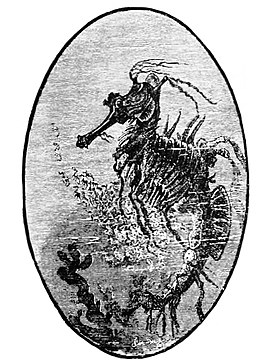Indian jugglers often keep these fishes in order to let them crawl about on land, and have the people enjoy the wonderful spectacle. Another fish, living in the Gulf of Panama, resembles the kangaroo, inasmuch as it possesses a bag-like receptacle in which it bears its eggs.
The most peculiar, however, of all fishes is the sea-horse (Hippocampus),  Fig. 3.—The Hippocampus and its Family. remarkable on account of its queer shape as well as on account of its strange homestead and habits of life. With their numerous joints and their circular tail, these fishes have more the appearance of a plant than of an animal. While swimming they keep in an upright position, holding their tail in readiness for the peculiar use to which they put it. Very quickly they coil it around sea-weeds, and then carefully watch the surrounding water, on the lookout for booty, which, when perceived, they pursue with great dispatch. It sometimes happens that, when two of these fishes meet, they encircle each other with their tails, and they often have a hard time of it before they can again separate. By the peculiar growth of a part of the epidermis on the sea-horse a perfect pocket is formed, in which their eggs are allowed to develop.
Fig. 3.—The Hippocampus and its Family. remarkable on account of its queer shape as well as on account of its strange homestead and habits of life. With their numerous joints and their circular tail, these fishes have more the appearance of a plant than of an animal. While swimming they keep in an upright position, holding their tail in readiness for the peculiar use to which they put it. Very quickly they coil it around sea-weeds, and then carefully watch the surrounding water, on the lookout for booty, which, when perceived, they pursue with great dispatch. It sometimes happens that, when two of these fishes meet, they encircle each other with their tails, and they often have a hard time of it before they can again separate. By the peculiar growth of a part of the epidermis on the sea-horse a perfect pocket is formed, in which their eggs are allowed to develop.
Yet another kind of fish possesses a form still more weird, and may, on account of its shape and color, be easily mistaken for floating sea-weeds. And in this peculiar resemblance lies its greatest safeguard. In like manner the sea-needle greatly resembles the sea-plants among which it lives, not only in form, but also in color, which it can easily change from a gray or brown to a bluish or greenish hue.—Translated for the Popular Science Monthly from Daheim.

